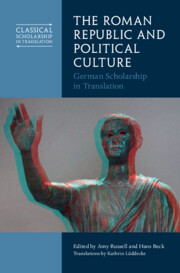63 results

The Roman Republic and Political Culture
- German Scholarship in Translation
- Coming soon
-
- Expected online publication date:
- December 2024
- Print publication:
- 31 October 2024
-
- Book
- Export citation
From infancy to eight: How early maternal mental health, emotion reminiscing, and language shape children’s mental health
-
- Journal:
- Development and Psychopathology , First View
- Published online by Cambridge University Press:
- 22 May 2024, pp. 1-15
-
- Article
-
- You have access
- Open access
- HTML
- Export citation
‘A more human approach … I haven’t found that really’: experiences of hoarding difficulties and seeking help
-
- Journal:
- Behavioural and Cognitive Psychotherapy / Volume 52 / Issue 1 / January 2024
- Published online by Cambridge University Press:
- 22 September 2023, pp. 1-13
- Print publication:
- January 2024
-
- Article
-
- You have access
- Open access
- HTML
- Export citation
Cooking behaviours after Diabetes Prevention Program (DPP) participation among DPP participants in Baltimore, MD
-
- Journal:
- Public Health Nutrition / Volume 26 / Issue 11 / November 2023
- Published online by Cambridge University Press:
- 05 June 2023, pp. 2492-2497
-
- Article
-
- You have access
- Open access
- HTML
- Export citation
Developmental care pathway for hospitalised infants with CHD: on behalf of the Cardiac Newborn Neuroprotective Network, a Special Interest Group of the Cardiac Neurodevelopmental Outcome Collaborative
-
- Journal:
- Cardiology in the Young / Volume 33 / Issue 12 / December 2023
- Published online by Cambridge University Press:
- 30 March 2023, pp. 2521-2538
-
- Article
-
- You have access
- Open access
- HTML
- Export citation
Shoreline modelling on timescales of days to decades
-
- Journal:
- Cambridge Prisms: Coastal Futures / Volume 1 / 2023
- Published online by Cambridge University Press:
- 01 February 2023, e16
-
- Article
-
- You have access
- Open access
- HTML
- Export citation
Interdisciplinary insights on the future of food systems research: perspectives from the next generation of research leaders
-
- Journal:
- Public Health Nutrition / Volume 25 / Issue 11 / November 2022
- Published online by Cambridge University Press:
- 09 August 2022, pp. 3235-3239
-
- Article
-
- You have access
- Open access
- HTML
- Export citation
Associations of maternal glucose markers in pregnancy with cord blood glucocorticoids and child hair cortisol levels
-
- Journal:
- Journal of Developmental Origins of Health and Disease / Volume 14 / Issue 1 / February 2023
- Published online by Cambridge University Press:
- 08 July 2022, pp. 88-95
-
- Article
- Export citation
Stakeholder input on a care planning tool to address unhealthy behaviors, mental health needs, and social risks: The value of different stakeholder perspectives
-
- Journal:
- Journal of Clinical and Translational Science / Volume 5 / Issue 1 / 2021
- Published online by Cambridge University Press:
- 07 October 2021, e188
-
- Article
-
- You have access
- Open access
- HTML
- Export citation
Understanding the dynamics of lion attacks on humans and livestock in southern Maasailand, Kenya
-
- Article
-
- You have access
- Open access
- HTML
- Export citation
Acknowledgements
-
- Book:
- The Social Dynamics of Roman Imperial Imagery
- Published online:
- 09 November 2020
- Print publication:
- 12 November 2020, pp xiv-xiv
-
- Chapter
- Export citation
2 - The Altars of the Lares Augusti
-
-
- Book:
- The Social Dynamics of Roman Imperial Imagery
- Published online:
- 09 November 2020
- Print publication:
- 12 November 2020, pp 25-51
-
- Chapter
- Export citation
Abbreviations
-
- Book:
- The Social Dynamics of Roman Imperial Imagery
- Published online:
- 09 November 2020
- Print publication:
- 12 November 2020, pp xv-xvi
-
- Chapter
- Export citation
Contributors
-
- Book:
- The Social Dynamics of Roman Imperial Imagery
- Published online:
- 09 November 2020
- Print publication:
- 12 November 2020, pp xiii-xiii
-
- Chapter
- Export citation
Index
-
- Book:
- The Social Dynamics of Roman Imperial Imagery
- Published online:
- 09 November 2020
- Print publication:
- 12 November 2020, pp 289-292
-
- Chapter
- Export citation
1 - Introduction
-
-
- Book:
- The Social Dynamics of Roman Imperial Imagery
- Published online:
- 09 November 2020
- Print publication:
- 12 November 2020, pp 1-24
-
- Chapter
- Export citation
Contents
-
- Book:
- The Social Dynamics of Roman Imperial Imagery
- Published online:
- 09 November 2020
- Print publication:
- 12 November 2020, pp v-vi
-
- Chapter
- Export citation
Epigraphic Appendix
- from 9 - Imagines et tituli
-
- Book:
- The Social Dynamics of Roman Imperial Imagery
- Published online:
- 09 November 2020
- Print publication:
- 12 November 2020, pp 234-246
-
- Chapter
- Export citation
Figures
-
- Book:
- The Social Dynamics of Roman Imperial Imagery
- Published online:
- 09 November 2020
- Print publication:
- 12 November 2020, pp vii-xii
-
- Chapter
- Export citation
Copyright page
-
- Book:
- The Social Dynamics of Roman Imperial Imagery
- Published online:
- 09 November 2020
- Print publication:
- 12 November 2020, pp iv-iv
-
- Chapter
- Export citation

